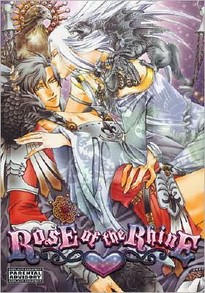Review
by Casey Brienza,Rose of the Rhine
GN
| Synopsis: |  |
||
King Dietrich of Bern is a brash young man with the fiery breath of a dragon. To protect him—and to keep him in line—is his loyal Meister Hildebrand, who has been at his side since he was a child. One day, the Princess Kriemhild challenges Dietrich to a duel with her fiancé, the immortal Siegfried. The winner receives a kiss from the princess. Needless to say, Dietrich couldn't be less interested, but Hildebrand insists that he go defend his honor. In the end, though, it will be the deeply-held love between the king and his retainer that wins the day as the duo dodges foe and female alike in order to find solace in each others' arms. |
|||
| Review: | |||
No one, but no one in the boy's love (BL) business loves exotic locales, historic settings, and costume drama as much as Megumu Minami, and with Rose of the Rhine, she is certain to match her fans' expectations. Based upon the medieval Norse epic poem, “Sagas of Dietrich,” this multi-chapter vision of homoerotic love might as well be a piece of well-conceived slash fanfiction. Indeed, the plot, which spans three chapters, actually parallels the original legend of Dietrich pretty closely. The Young King's duel with Siegfried, for example, was lifted practically whole-cloth from the source material, as is the ironic fact that it is Hildebrand, not Dietrich, who seems to do most of the monster-slaying. Only the romance is all-original, and the two characters' infatuation with each other seems downright perfunctory when compared to Minami's own infatuation with her source material. (Of course, Hildebrand happens to bear a striking resemblance to Peter Jackson's interpretation of Legolas from Lord of the Rings—right down to the vaguely pointy ears—but that's another story entirely.) Minami writes at length in her afterword about the original poem and her impressions of it, just in case her readers are not familiar with the literature. The fourth and final chapter is an unrelated bonus story titled “Tale of a Mirage,” about the brother of a yakuza don and the son of a deceased man who owed the yakuza tremendous amounts of money. Your standard “Does he hate me or does he love me?” BL yomikiri, its relative simplicity in comparison to “Rose of the Rhine” actually allows the fraught emotional minefield for which the genre is justifiably famous to take center stage in a way the previous gaudy medieval fantasy does not. Though a bit confusing in places, it's a reasonably pleasing little love story with a measure of genuine appeal and the ideal way to conclude the volume. As always, Minami's artwork is distinctive and exquisite with plenty of evocative fantasy detail. This volume's cover is among the best, if not the best, she has ever done. Gorgeous costumes, flowing tresses, and rangy male bodies are, as always, standard, although the swords 'n sorcery plot of “Rose of the Rhine” reveals a rarely disclosed weakness in her artistic repertoire—action scenes. The swordfights in this volume are not convincing, straining her merely passable skill in cinematic layout to the breaking point and beyond. Thank goodness that the lovely characters and settings sustain the inevitable rereading that this weakness necessitates. Stylistically, Rose of the Rhine signals a gradual shift. Trends in BL come and go, and these days the sharp, impressionistic look is in. Those with keen eyes will note the difference between this work and the somewhat earlier Pleasure Dome (also available in English from Media Blasters). Outlines are becoming more angular and less well-defined, bodies a bit less firm and rounded. Even her signature chibi figures are looking a bit less cute. Nevertheless, the art is still instantly recognizable and uniquely Minami, and as a creator who has worked in the manga industry for well over a decade now, she is one of those rare BL mangaka who seems capable of simultaneously staying both fashionable and true to herself. Unfortunately, the Media Blasters edition of Rose of the Rhine is, like many of that company's other manga releases, lamentably imperfect. Some of the characters' names are spelled different ways in different places. The most egregious inconsistency is involves the name “Kriemhild,” which is occasionally written, as if it were supposed to be dirty joke, “Creamhilt.” Worst of all, though, is the sloppy formatting. Entire blocks of text recede so deeply into the binding that, short of ripping the binding apart, they are flatly unreadable. Fortunately, none of said text is particularly important. After all, if you were looking for nuanced dialogue and elegant prose, you are looking in precisely the wrong place. The pretty art—and the pretty boys—are what is important here, and eye candy does not need editorial perfection to be appreciated. |
| Grade: | |||
|
Overall : B+
Story : B
Art : A-
+ Effective use of literary source material and exotic settings. Distinctive, attractive art. |
|||
| discuss this in the forum (4 posts) | | |||
| Production Info: | ||
|
Full encyclopedia details about Release information about |
||